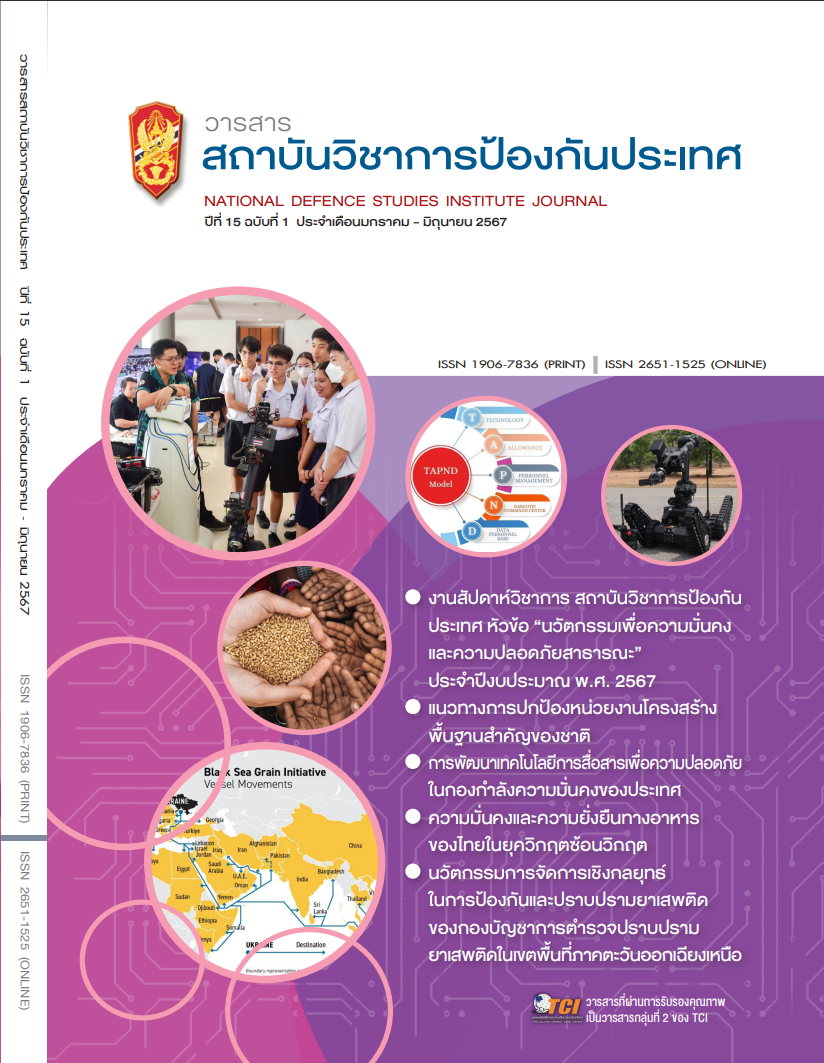Organizational Image Management for Creating a Credibility of Japan Self-Defense Forces
Main Article Content
Abstract
This article aims to study concepts regarding how to manage organizational image and credibility, including analyzing Japanese Ministry of Defense’s security policy as appeared in the white paper (Year 2023). Currently, there are changes and challenges in the conflicts and crisis throughout the World today. Japan recognizes that defense efforts based on only one, is not really practical. Japan, therefore, has to reinforce the defense architecture approach, including strengthening deterrence and response capabilities of the Japan-U.S. alliance. This will also include reinforcement of collaboration with like-minded countries and others through cooperation in defense equipment and technology.
These approaches will enhance under standing and acceptance among the Japanese publics and the world community in positive attitudes towards the Japanese self-defense forces. This will help creating positive images for the Japanese self-defense forces in maintaining capabilities and expertise to effectively perform self-defense, peace keeping, humanitarian assistance, and disaster reliefs in domestics and abroad. Japan should further increase roles in the World’s security stages to enhance trustworthiness and reliance for the people in both peacetime and in crisis. This will also demonstrate Japanese sincerity in handling conflicts and crisis among the international community with expertise and capability. With these approaches, the publics will have more trusts, attractiveness and organizational images in the Japanese self-defense forces.
Article Details

This work is licensed under a Creative Commons Attribution-NonCommercial-NoDerivatives 4.0 International License.
The articles, images, tables, graphs, written content, and opinions published in this journal are solely those of the authors and do not necessarily reflect the views or positions of the National Defence Studies Institute or its academic affiliates.
References
ปัญญา ศรีสิงห์. (2553). ภายใต้กรอบรัฐธรรมนูญ ญี่ปุ่นอยู่รอดได้อย่างไร. วารสารเอเชียตะวันออกศึกษา, 14(2), 97-102.
โมโน 29. (2566). 76 ปี รธน. ญี่ปุ่น ถกแก้มาตรา 9 กรอบอำนาจกองกำลังป้องกันตนเอง. สืบค้นเมื่อ 15 พฤศจิกายน 2566, จาก https://mono29.com/news/438123.html
สถาบันเทคโนโลยีป้องกันประเทศ. (2565). รายงานวิเคราะห์เทคโนโลยีป้องกันประเทศ.
Baker, M. J., & Churchill, G. A. (1977). The impact of physically attractive models on advertising evaluations. Journal of Marketing Research, 14(4), 538-555.
Braverman. (1968). Credibility Theory: A Probabiltics Development. Journal of Risk and Insurance, 35(3),
-423.
Dholakia, R. R., & Sternthal, B. (1977). Highly Credible Sources: Persuasive Facilitators or Persuasive Liabilities?. Journal of Consumer Research, 3, 223-232.
Goldsmith, R. E., Lafferty, B. A., & Newell, S. J. (2000). The Impact of Corporate Credibility and Celebrity Credibility on Consumer Reaction to Advertisements and Brands. Journal of Advertising, 29(3). Retrieved from https://doi.org/10.1080/00913367.2000.10673616
_______. (2002). The Dual Credibility Model : The Influence of Corporate and Endorser Credibility on Attitudes and Purchase Intentions. Journal of Marketing Theory and Practice, 10(3). Retrieved from https://doi.org/10.2307/41304270
Hovland, C. I., Janis, I. L., & Kelley, H. H. (1953). Communication and Persuasion. New Haven: Yale University Press.
Kotter. (2014). Accelerate: Building Strategic Agility for a Faster-Moving World. Harvard Business Review Press.
Massey, J. E. (2003). A Theory of Organizational Image Management: Antecedents, Processes & Outcomes. In the International Academy of Business Disciplines Annual Conference, held in Orlando. Retrieved from http://www.citeseerx.ist.psu.edu
_______. (2016). A Theory of Organizational Image Management. International Journal of Management and Applied Science, 2(1).
Kahle, L. R., & Homer, P. M. (1985). Physical attractiveness of the celebrity endorser: A social adaptation perspective. Journal of Consumer Research, 11(4), 954-961.
Li, Y., Wang X., & Yang, Z. (2011). The Effects of Corporate-Brand Credibility, Perceived Corporate-Brand Origin, and Self-Image Congruence on Purchase Intention: Evidence from China’s Auto Industry. Journal of Global Marketing, 24(1), 58-68.
Minstry of Defense. (2023). Defense of Japan 2023 (Annual White Paper). Retrieved from https://www.mod.go.jp/en/publ/w_paper/wp2023/DOJ2023_Digest_EN.pdf
Morgan, R. M., & Hunt, S. (1996). The Commitment-Trust Theory of Relationship Marketing. Journal of Marketing, 58(3), 20-38.
Newell, S., & Goldsmith, R. E. (2001). The development of a scale to measure perceived corporate credibility. Journal of Business Research, 52(3). Retrieved from http://psycnet.apa.org/doi/10.106/S0148-2963(99)00104-6
Ohanian, R. (1990). Construction and validation of a scale to measure celebrity endorsers' perceived expertise, trustworthiness, and attractiveness. Journal of Advertising, 19(3), 39-52.
Pfau, M., Haigh, M. M., Sims, J., & Wigley, S. (2008). The Influence of Corporate Social Responsibility Campaigns on Public opinion. Corporate Reputation Review, 1(2), 145-154.
Sobel, J. (1985). A Theory of Credibility. Review of Economic Studies, 52(4), 557-573.
Yahoo Japan New. (2023). 自衛隊への好印象度は90.8%. Retrieved November 15, 2023 from https://news.yahoo.co.jp/expert/articles/453ccb71ef65343b272f57d6872da70a2004d2e4


